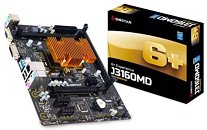Monday, May 16th 2016

BIOSTAR Announces the J3160MD System Board
BIOSTAR proudly announces its small yet powerful motherboard from the new motherboard featuring integrated Intel Braswell Refresh SoC processors. Featuring the new Celeron J3160 quad-core processor which has clock speeds of 1.6Ghz and has a Turbo clock up to 2.24Ghz, this little machine can deliver unprecedented performance from a SoC-based system. To help improve performance, support for DDR3L-1600 DIMM modules is now possible with a maximum supported capacity of 16GB per slot giving the BIOSTAR J3160MD great memory flexibility.
The latest generation Intel HD graphics is baked into the new BIOSTAR J3160MD featuring peformance improvements over last-gen Intel IGPs. This gives the board excellent performance and support to play 4K UltraHD content and deliver a stunning multimedia experience from a small package.
USB3.0 allows faster connectivity to modern components and peripherals with support for up to 5Gbps bandwidth and is fully compatible with older USB2.0 devices.For more information, visit the product page.
The latest generation Intel HD graphics is baked into the new BIOSTAR J3160MD featuring peformance improvements over last-gen Intel IGPs. This gives the board excellent performance and support to play 4K UltraHD content and deliver a stunning multimedia experience from a small package.
- 14nm Processor - Intel's die-shrink allows the new Braswell Refresh SoC processors to operate with less current while improving performance and allows more clock rate headroom for frequency increases on lower workloads when necessary along with the other technical advantages brought on by the die-size reduction.
- Improved HD Graphics - An improved Intel HD Graphics GPU will be baked into the new SoCs which improves performance for multimedia tasks such as watching HD videos and better desktop graphics for productivity allowing for a richer experience with an increase in execution units to handle today's more demanding visual processing.
- More Memory Bandwidth - Native support for DDR3L-1600 allows the new Braswell Refresh SoCs to access memory at a faster rate for improved system responsiveness. This changes results in up to 40% power savings and double graphics performance. There is also 20% more memory bandwidth in the new DDR3L-1600 versus the old DDR3L-1333, plus twice the speed for storage against the older SoCs.
USB3.0 allows faster connectivity to modern components and peripherals with support for up to 5Gbps bandwidth and is fully compatible with older USB2.0 devices.For more information, visit the product page.


19 Comments on BIOSTAR Announces the J3160MD System Board
umm? Those are some weird looking pci slots.
- PCI-E x16 2.0 running @ x1
- Pair of PCI-E x1 @ x1
- and the last one goes to NIC.
Wondering why would they make an x16 slot, if there are desktop/workstation graphics options for PCI-E x1 (especially for that platform). It's not like someone actually needs anything higher than GT730 in it, given that the built-in IGP is already quite capable of driving multiple displays... I guess they are just that funny lately.
Sata and USB is covered by the chip itself directly.
Also are we sure the slot is only 1x and not 2x? The CPU can do x2/x1/x1 and we already know the specs are wrong because they also list a pair of PCI slots whereas the photos of the physical board show a pair of PCI-E x1 slots (as the specs have been C&P from the J3160MP).
Celeron J3160 can also have a 4x1 configuration.